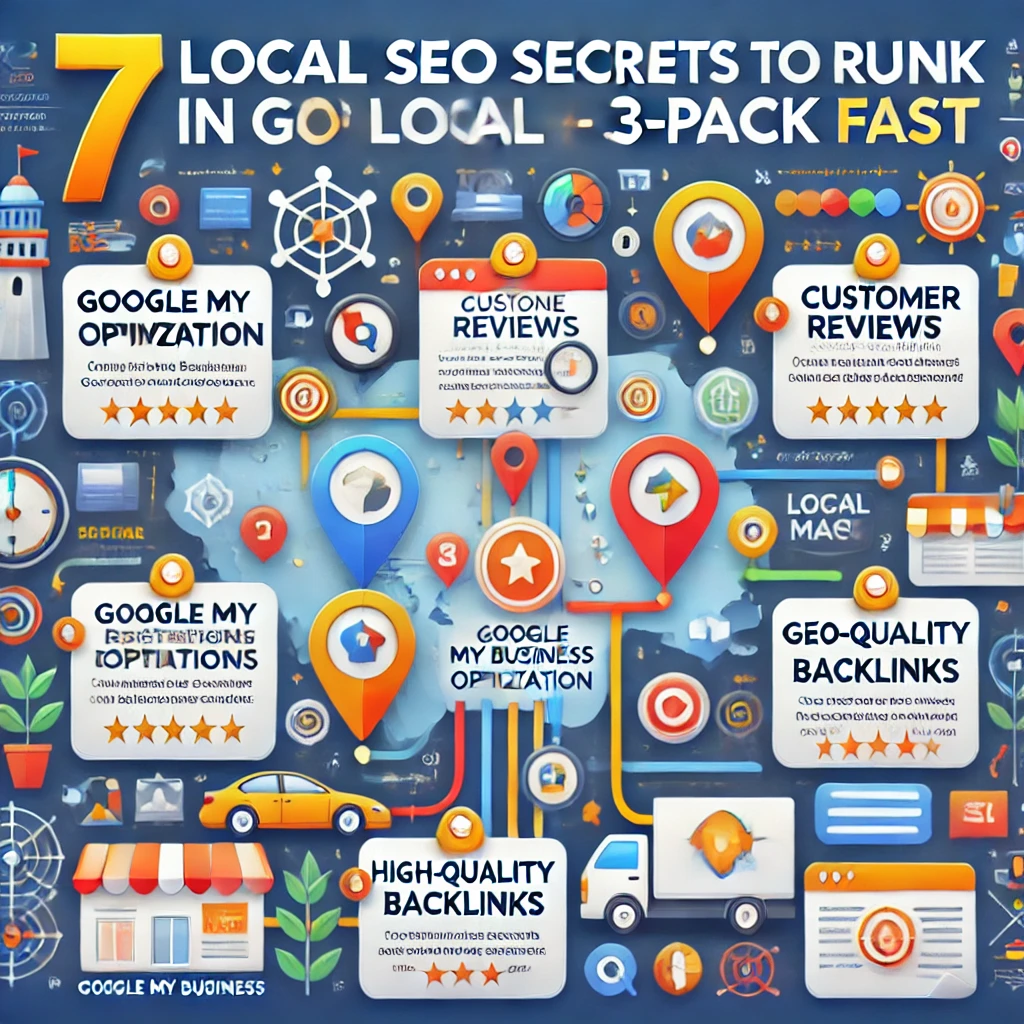
Ever wondered why some businesses always dominate Google’s Local 3-Pack while yours struggles to break into the top three?
SEO agencies love keeping their best strategies under wraps—but we’re here to reveal the secrets they don’t want you to know.
This in-depth guide will show you how to optimize your local SEO like a pro, leveraging the most powerful ranking techniques to secure a spot in Google’s coveted Local 3-Pack.
Let’s get started!
Why Google’s Local 3-Pack Matters
Google’s Local 3-Pack is the prime real estate for local businesses. These top three listings get the most clicks, calls, and customers compared to other search results.
Key Ranking Factors
- Relevance: How well your business matches the searcher’s intent.
- Proximity: How close your business is to the searcher’s location.
- Prominence: How well-known and trusted your business is.
But there’s more to it than just these basics. Let’s break down the seven most effective strategies to claim your spot in the Local 3-Pack.
1. Optimize Your Google My Business (GMB) Profile
Your Google My Business (GMB) listing is the foundation of your local SEO strategy. Without proper optimization, you’re missing out on rankings and customers.
How to Optimize Your GMB Profile
- Complete every section: business name, address, phone number (NAP), website, business hours, and attributes.
- Upload high-quality images and videos showcasing your business.
- Regularly post updates, offers, and events using Google Posts.
- Select the right business categories that match your services.
- Write a compelling, keyword-rich business description (but keep it natural).
Pro Tip: A complete and optimized GMB profile significantly increases your chances of ranking in the Local 3-Pack.
2. Generate More High-Quality Customer Reviews
Customer reviews are a major ranking factor for local SEO. Businesses with higher ratings and frequent reviews rank better.
How to Get More Reviews (Legally!)
- Ask satisfied customers right after they make a purchase.
- Send follow-up emails or SMS messages with a direct review link.
- Respond to every review (positive and negative) to show engagement.
- Encourage detailed, keyword-rich reviews by asking specific questions.
For example, instead of:
“Great service!”
Encourage:
“The deep-tissue massage at Relax Spa was incredible! The ambiance was soothing, and the therapist knew exactly how to relieve tension. Highly recommended!”
Why it works: Google considers reviews as content—more relevant keywords mean higher rankings!
3. Maintain Local Citations & NAP Consistency
A local citation is any mention of your business on the web, such as directories like Yelp, Angi, Apple Maps, and BBB.
Why Citations Matter
- Google cross-checks your business information across different websites.
- Inconsistent details (name, address, phone number) confuse Google and hurt rankings.
How to Fix NAP Inconsistencies
- Get listed on high-authority directories like Yelp, Bing Places, and industry-specific sites.
- Use tools like Moz Local or BrightLocal to scan for incorrect listings.
- Correct any errors in your business name, address, or phone number immediately.
4. Build High-Quality Local Backlinks
Not all backlinks are equal—for local SEO, local backlinks are the key to ranking in Google’s Local 3-Pack.
How to Get Local Backlinks
- Sponsor local events and get featured on their websites.
- Join local business associations (they usually have high-authority directories).
- Partner with local bloggers and news websites for coverage.
- Submit to city and industry directories with high domain authority.
Pro Tip: A backlink from your city’s news website is far more valuable than one from a random global blog!
5. Create Geo-Targeted Content & Location Pages
Content isn’t just for blogs—it’s a powerful tool for local SEO when done right.
How to Leverage Geo-Targeted Content
If you serve multiple locations, create separate location pages instead of a single generic page.
Example:
❌ Bad: One page listing: “We serve Los Angeles, San Diego, and San Francisco.”
✅ Good: Three separate pages:
- “Best Plumbing Services in Los Angeles”
- “24/7 Emergency Plumbers in San Diego”
- “Affordable Plumbing Solutions in San Francisco”
Each Page Should Include:
- Location-specific keywords.
- Local testimonials and case studies.
- An embedded Google Map with your business location.
6. Increase User Engagement & Behavioral Signals
Google tracks user behavior to determine rankings. If people click your listing and engage with your content, Google rewards you with higher rankings.
How to Boost Engagement
- Add a Google My Business Q&A section with FAQs.
- Use “Call Now” and “Get Directions” buttons on your website.
- Improve your website speed and mobile-friendliness.
- Use real customer photos instead of stock images.
7. Embed Google Maps on Your Website
Embedding Google Maps on your website sends strong local signals to Google and helps customers find you easily.
How to Embed Google Maps:
- Go to Google Maps and search for your business.
- Click the Share button and select Embed map.
- Copy the embed code and paste it into your website’s Contact or Location page.
Why it works:
- It reinforces your business’s physical location for Google’s algorithm.
- It improves the user experience, leading to higher engagement rates.
Final Thoughts: Dominate the Local 3-Pack Today!
Now that you know the 7 local SEO secrets that agencies won’t tell you, it’s time to take action!
Here’s Your Local SEO Checklist:
✅ Fully optimize your GMB profile ✅ Get more customer reviews ✅ Ensure NAP consistency across all listings ✅ Build high-quality local backlinks ✅ Create geo-targeted content ✅ Boost engagement & behavioral signals ✅ Embed Google Maps on your website
Implement these strategies and watch your business climb to the Google Local 3-Pack faster than ever!
Need expert help with content marketing? Check out our services!
Learn about Best Digital Marketing Courses in Laxmi Nagar